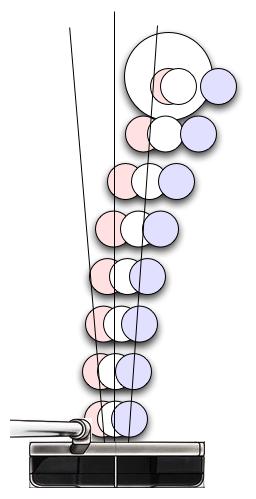 It’s quite possible to cheat within the rules of golf… and make more of those testy short, breaking putts when doing it. To the right you see a putt that breaks to the right a few inches (obviously not everything is to scale). You see the paths of three balls: the red ball was struck ¼-inch towards the heel, the blue ball ¼-inch towards the toe, and the white ball dead center. All were struck with the same stroke and speed.
It’s quite possible to cheat within the rules of golf… and make more of those testy short, breaking putts when doing it. To the right you see a putt that breaks to the right a few inches (obviously not everything is to scale). You see the paths of three balls: the red ball was struck ¼-inch towards the heel, the blue ball ¼-inch towards the toe, and the white ball dead center. All were struck with the same stroke and speed.
Two of the balls go in the hole. The white ball – a stroke with perfect sweet spot contact – went into the hole, as did the red ball. The blue ball missed low, even though it missed the sweet spot by the same margin as the red ball. How is this true?
Shots struck off-center are weaker. On a breaking putt, a weak putt breaks more. Shots struck off-center also start offline (see the three lines): towards the heel, putts start left and towards the toe, to the right. A slightly slower putt that’s given more room to break (red ball) goes into the hole while a putt with the same diminished speed started below the perfect line misses completely (blue ball).
Use this to your advantage on the course: when you’re faced with a short breaking putt, set up with the ball not on the sweet spot of your putter, but slightly to the high side just under ¼ inch. The “high side” is the opposite of the way the putt breaks: the heel on left-to-righters, and the toe on right-to-lefters (for right-handed putters, anyway).
Building in this small “margin of error” allows you to get the ball on a line and with a speed that rolls the ball into the hole far more frequently. We guarantee you’ll make more of these putts… simply by “cheating” legally!
